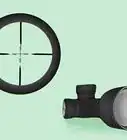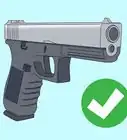This article was co-authored by Bryan Villella. Bryan Villella is the Lead Firearms Instructor and Owner of Don't Be A Sitting Duck in Kissimmee, Florida. Bryan has nine years of professional experience and is an NRA and Florida State Certified “K” Instructor. He leads certified training courses necessary to get licensed through the state to work in the private security field. He prioritizes safety and building comfortable environments for people to learn skills safely.
wikiHow marks an article as reader-approved once it receives enough positive feedback. In this case, several readers have written to tell us that this article was helpful to them, earning it our reader-approved status.
This article has been viewed 362,598 times.
Though the title sounds a bit absurd, it is quite possible to be very accurate over long distances with a pistol. It takes patience, a little bit of talent, dexterity, and lots of practice. This article will give you pointers on how to become a better shot with any pistol at distances of 100 yards (91.4 m), 200 yards (182.9 m), and beyond. Keep in mind (especially with handguns) you may limit how well you are able to accomplish this based on the amount of trigger-time and patience you put into your exercises.
Steps
-
1Choose a good pistol. Though any pistol can be wielded better, the weapon can seriously limit the ultimate success of being a marksman with your pistol. Here are some generalities to look at when purchasing a weapon. The generalities deal with single-shot, long-range accuracy; this is not including considerations like self defense, durability, or price. None of these are concrete as there are exceptions to all of them, and a pistol that fits you personally is always the best choice.
- Larger pistols are more accurate than smaller ones.
- Larger pistols will fit more peoples' hands than smaller ones.
- Longer barrels mean higher muzzle velocities which mean flatter bullet trajectories.
- Lighter, high-velocity bullets are more accurate at common pistol ranges (out to 50+ yards).
- Heavy bullets are more accurate at longer ranges (100+ yards).
- Smaller calibers are cheaper to shoot, which means you can practice more.
- Smaller calibers mean less recoil, which in turn mean faster follow-up shots, or more people can comfortably shoot it.
- For semi-automatic pistols, double-action only (DAO) (AKA Quick Action) pistols are less accurate than double/single-action (DA/SA) or single-action (SA).
- Expensive guns aren't necessarily accurate or shoot well often due to limits of the user.
- Your gun is more accurate than you are.
-
2So from the generalities above, a large SA (or DA/SA) pistol with a long barrel would be best. Examples of such weapons are the H&K USP Elite, Desert Eagle 14-inch barrel, or target pistols by Hämmerli and other high-quality target gun makers. These are not cheap pistols by any means, but they are match-grade firearms and will serve you well.
- Always try every firearm you intend on buying before you buy it. Try to go to a range that carries that firearm type and test it. Make sure you're comfortable with gripping, aiming and handling it.
Advertisement -
3While a public shooting range is a common place to practice, it is not necessarily the most optimal location to practice your long-range accuracy. A friend with lots of land and a safe place to shoot is often best. This allows you to set up custom distances to targets and become adept at any range with any size target.
- Treat every visit to the range as an opportunity to learn.
-
4Start your practice out with some stretches. This sounds really weird, but it will loosen your muscles and allow you to have more steady hands and body.
-
5Do some warm-up shots (maybe at 15 yards). Find where you (and your gun) are shooting. If you find yourself not able to keep consistent groupings at this range, practice shooting very slowly and being patient until your sights move over your target. Once you figure out where your sights are compared to where you are shooting (optimally, the bullet should end up in line with your front sight, but hopefully slightly above it – if you know how far off you are, a gunsmith can likely correct your sights) you can continue to the practice you came for.
-
6When you first start shooting at long-distance targets, it is best to start closer and move your way up. A good starting distance is about 25 yards (22.9 m). Though this is much further than most people are used to, if you are going to be good at long range, you must practice at long range. When you start you may find yourself unable to hit a body-sized target consistently, but over time you will find you can hit cans 90% of the time at this range.
-
7Your stance should be what is most comfortable to you. It is often best to (if you are right handed) to place your left foot forward, and about shoulder-length diagonally behind that, your right foot. Bring your right hand straight forward as if you are attempting to touch the target, keep your elbow loose, but close to lock; this is the hand that will hold the grip of the gun. Your left arm will be bent at about a 120 degree angle. Your right arm controls the vertical angle of the gun; your left arm controls the horizontal position. You left elbow should be about pointed directly at the ground.
- Prone: You need to practice lying on the ground. Your stance on the ground should be such: lay on your belly. Then roll slightly to the firing side. Place your support knee and elbow down on the ground. You will be a bit sideways, but your firing arm will be completely flush with the ground with your head resting on it looking down the sights. This allows burden-free breathing and a very stable platform.
- Crouching: This can give you a very stable platform for shooting accurately. Put your firing leg behind you and essentially sit down on the heel of your foot. Your firing knee will be on the ground and your toe. Rest your support elbow on your support knee. You are in a tripod position (support foot, firing toe and firing knee), and you are in an arrangement where you can move quickly (practice moving periodically to and from the crouching position).
-
8Lean your head slightly to the right to line up your right eye with the sights of the gun. You may need to move your right wrist to adjust the sights to point forward. To aim, move your body (in this stance) until the gun lines up with the target.
-
9Slowly breathe, relax, and attempt to lineup the sights over the target. For target shooting, it is often best to overlay the front sight on your intended target, while focusing on the front sight, or somewhere in between the target and your front sight (this should only be used if you have ample time to aim). Do not focus on the target; focus near the front sight, concentrating all of your mind on creating a perfect "sight picture" where the rear sight and front site line up completely. The target should be a blur beyond your firearm. If speed is an issue: 99% of the time it would be best to focus completely on your front sight.
-
10You will find with practice that your breathing and ability to not get excited and remain calm are the primarily challenges when keeping your sights on your target. This can only be overcome with practice. Breathe in and out normally before shooting, then take a slightly deeper breath before exhaling completely and relaxing your lungs. It is during this relaxation point (*not* forcing air out, just relaxing) that your shot should be taken.
-
11The "sight picture" should, on traditional iron sights, resemble a shape like III, where the front sight is framed perfectly by the borders of the rear site. Keep in mind this means horizontal as well as vertical! This perfect picture should then be placed below the target (not obscuring it) and the gun should then be fired.
-
12A gun should be 'zeroed' (adjusted) to aim accurately when the sight picture is placed directly below the target. It is in this manner that making artificial adjustments (e.g., aiming left or high) is avoided and a gun aimed straight and true to a perfectly aligned sight picture will deliver a round to the desired target accurately.
-
13Different ammunition shoots differently (and more or less accurately) for different guns. Try various types for your firearm and determine which groups best for your gun.
-
14Novice shooters often pride themselves on a bulls-eye when the rest of their shots lie all over the target. Even a handful of marbles thrown at the target will probably hit here and there; this doesn't demonstrate skill, only luck. Concentrate on grouping your shots close together; this is the first sign of an effective marksman and demonstrates consistency in shooting.
-
15Once you have the sights correctly aligned and have placed a perfect sight picture on your target, you want to slowly pull the trigger directly toward the back of the gun, with the trigger on or past the last joint on your index finger (pull straight, slowly, and consistently between shots). With a DA/SA pistol, you should have already pulled the hammer back (it is now in SA mode). Based on the gun, you may have anywhere between a 2 and 8 lb pull. The lighter the trigger, the easier it is to be accurate (though with DAO pistols, there is a "sweet spot" that can be found to reduce the trigger pull; find it by firing a shot, without releasing the trigger; slowly move your finger forward until the trigger clicks, you can then pull the trigger again to fire).
-
16When the shot fires see where the bullet landed (high, low, left, right, or any combination). This may take some practice, but you will be able to determine if the shot missed because the sights aren't lined up, your arm was swaying and/or your timing was off, or you anticipated the shot.
- When a shot lands left of the target for a right-handed person, it means they are squeezing the whole gun instead of just the trigger when they are firing.
- When a shot lands right of the target for a right-handed person, it means they either have too much finger on the trigger or they are pushing in with their grip-fingers on the firing hand.
- Shots very seldom land high, but when they do, it sometimes means the shooter is anticipating the recoil and pull up before a shot.
- If a shot lands low, it is often because the shooter is either mashing the trigger (gripping the trigger and the gun, and pulling too quickly) or more likely because they are anticipating the recoil and thus pushing down on the gun before it actually fires.
- Anticipating the recoil is one of the most common reasons a person cannot shoot a gun accurately. The person will expect the gun to recoil, so before the round has fired, they will move their wrist, pointing the gun down or up, depending on the shooter. A very easy way to identify this is by handing the person a gun they are very familiar with. Make sure it is unloaded, but tell them it is loaded. When they line up their shot, and pull the trigger, they will move the gun themselves.
- To break this habit, here are a few techniques.
- The simplest is to concentrate on your trigger pull. Point in to the target and slowly pull the trigger. Just keep building pressure as slowly and evenly as you can. It could take up to 10 seconds for the gun to fire. The purpose is to get a "surprise break" meaning that you don't know when the gun is going to fire, thus you can't compensate for it. A gun with a smooth trigger and a crisp break are more likely to prevent this situation as you are less likely to feel when the gun is going to fire as your pull the trigger.
- The second technique is essentially the same, except it removes all possibility of the user anticipating the recoil. Point in to the target and keep your front sight on the target as best you can. Have a friend put their finger in the trigger guard and pull the trigger for you (either your finger on the index point, or on the trigger under their finger). Make sure the person actually doing the pulling does it very slowly and keeps their hand (mainly their thumb) away from the back of the gun (where the slide will clip them). This method is very awkward, but it will prove that trigger pull is one of the most important elements in firing a gun.
- Many shooters, even experienced ones, flinch without realizing it. Anticipating the recoil can manifest itself as subtle movements that are masked by the actual recoil of the gun, and therefore go unnoticed by the shooter or observers. You can easily test this using a snap cap http://en.wikipedia.org/wiki/Snap_cap. As stated in the link, “A snap cap is a device which appears similar to a standard firearm cartridge but contains no primer or projectile and is used to dry fire the weapon. Snap caps usually contain a spring-dampened false primer which absorbs the force from the firing pin allowing you to safely test-fire the gun without damaging the components.”
- Have a friend load your gun for you, but replacing one loaded round with a snap cap of the same caliber, positioned in the magazine (for a pistol) or cylinder (for a revolver) at random. As you proceed to fire all rounds, you’ll eventually find the snap cap, but you won’t know it until after you’ve pulled the trigger. At that moment, it will be obvious to you – If your site picture is rock steady, you’ve mastered the weapon’s recoil. If the gun jumps in your hand like a live round just went off, you need more practice. This is a simple, inexpensive test, but the results may surprise you.
-
17Practice at this range until you consistently are able to hit a chest-sized target (about a 20-inch diameter circle). Move the target back about 10 yards (9.1 m). Practice the cycle again. Maintain constant breathing patterns. If your sights are off, get new ones put on to compensate, or have a gunsmith fix the current ones. The 3-dot sight system is the preference of some, but other people prefer different style sights. Adjustable sights also make it easy to change the zero-point on your gun at any point.
- After you move the target back a time or two more, you will find that you are able to practice and eventually be able to consistently hit that chest-sized target at further and further distances.
- At some point, go back to the close target, and impress yourself at how well you are able to make tight groupings. This way you give yourself more confidence as you are able to see marked improvement.
-
18If your sights hit in the correct location (not high or low) at 40 or 50 yards (36.6 or 45.7 m) (this is best), you will find that at 60 or 70 yards (54.9 or 64.0 m) you will need to compensate for bullet drop by aiming higher; it may only be a couple inches, but you will need to get used to it.
- At 100 yards (91.4 m) there is significant bullet drop (about 10-15 inches for a standard .45), and wind becomes a bit of a factor. While standing you may find you can go further than 100 yards (91.4 m). Push yourself and find your limit. While prone our crouching with a support, you will find you can land consistent shots out to 200 yards (182.9 m).
- Terminal ballistic abilities at 200 or more yards for the most common pistol are questionable. At very long distances heavier bullets hold a greater percentage of their energy due to aerodynamic coefficients.
- At 100 yards (91.4 m) there is significant bullet drop (about 10-15 inches for a standard .45), and wind becomes a bit of a factor. While standing you may find you can go further than 100 yards (91.4 m). Push yourself and find your limit. While prone our crouching with a support, you will find you can land consistent shots out to 200 yards (182.9 m).
Community Q&A
-
QuestionIf I shake a lot how can I over come it?
 Community AnswerTake a deep breath and let it out slowly. Use your left hand to steady the pistol.
Community AnswerTake a deep breath and let it out slowly. Use your left hand to steady the pistol. -
QuestionIs it OK to use a Glock for sniping?
 Community AnswerSure, if you're good enough with it.
Community AnswerSure, if you're good enough with it. -
QuestionIf I use a 9mm, should I try and prevent the gun from rising on recoil or is the bullet not affected by the recoil?
 Community AnswerThe bullet is gone, so it won't be affected. The issue most people have is either 'flinching' or anticipating the kick. In short, thinking the kick is going to alter the course, or anticipating the fire and flinching (it is instinctive, after all) is a very common reason people miss. The trick is to have a smooth, consistent trigger pull, or squeeze. Don't jerk the trigger or hesitate when firing. Rapid firing requires re-positioning the gun between shots to compensate for movement due to recoil, but this is done after the shot, not during firing.
Community AnswerThe bullet is gone, so it won't be affected. The issue most people have is either 'flinching' or anticipating the kick. In short, thinking the kick is going to alter the course, or anticipating the fire and flinching (it is instinctive, after all) is a very common reason people miss. The trick is to have a smooth, consistent trigger pull, or squeeze. Don't jerk the trigger or hesitate when firing. Rapid firing requires re-positioning the gun between shots to compensate for movement due to recoil, but this is done after the shot, not during firing.
Warnings
- Be sure to know what is down range. Bullets can travel for miles or can bounce and ricochet into unintended directions.⧼thumbs_response⧽
- Any firearm should only be shot in a safe and legal location. Be aware of state and local laws on use and transportation of a firearm and follow them carefully. Laws change drastically between states and can change between counties or even cities.⧼thumbs_response⧽
- A pistol can inflict much harm or even death. Be sure to always point the pistol in a safe direction and never point it at something you do not intend to shoot.⧼thumbs_response⧽
- Firearms are dangerous. Only use a pistol or other firearm if you are an experienced shooter or have a very experienced shooter directly supervising you.⧼thumbs_response⧽
Things You'll Need
- A pistol (any caliber, any size, but take the generalities mentioned above into consideration).
- Ammunition (the caliber of your pistol). Be sure this ammunition is from a reputable source (manufactured is best). Self-loaded or reloaded ammunition can be dangerous and can damage your gun.
- If you intend to shoot outdoors: outdoor clothing. Wear clothes that are warm enough for the weather expected. Pants are always recommended. If you are located where there may be others with firearms (for example: while hunting), it is often best to wear a bright orange vest or shirt.
- Eye and ear protection are essential. Hot brass ejected from a semi-automatic can damage eyes and loud reports can damage hearing very quickly.
-With-a-Pistol-Step-1.webp)
-With-a-Pistol-Step-2.webp)
-With-a-Pistol-Step-3.webp)
-With-a-Pistol-Step-4.webp)
-With-a-Pistol-Step-5.webp)
-With-a-Pistol-Step-6.webp)
-With-a-Pistol-Step-7.webp)
-With-a-Pistol-Step-8.webp)
-With-a-Pistol-Step-9.webp)
-With-a-Pistol-Step-10.webp)
-With-a-Pistol-Step-11.webp)
-With-a-Pistol-Step-12.webp)
-With-a-Pistol-Step-13.webp)
-With-a-Pistol-Step-14.webp)
-With-a-Pistol-Step-15.webp)
-With-a-Pistol-Step-16.webp)
-With-a-Pistol-Step-17.webp)
-With-a-Pistol-Step-18.webp)
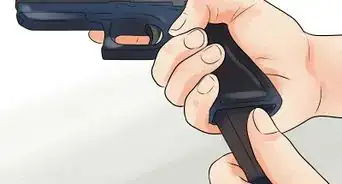

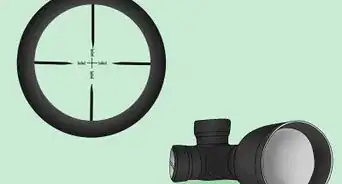
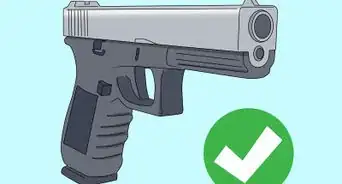
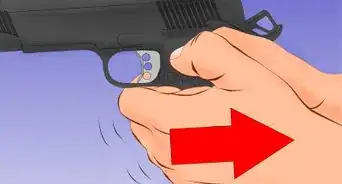
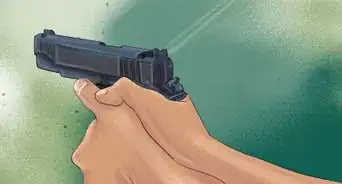
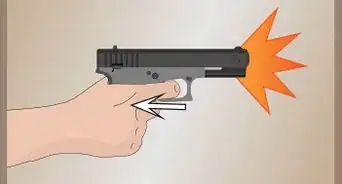
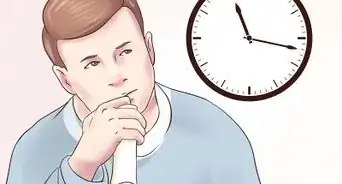

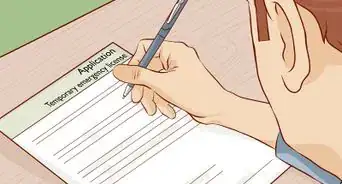

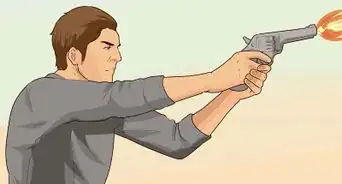
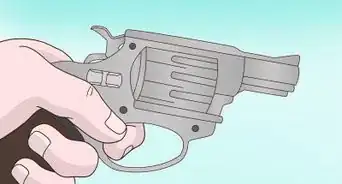
-Step-18-Version-3.webp)











